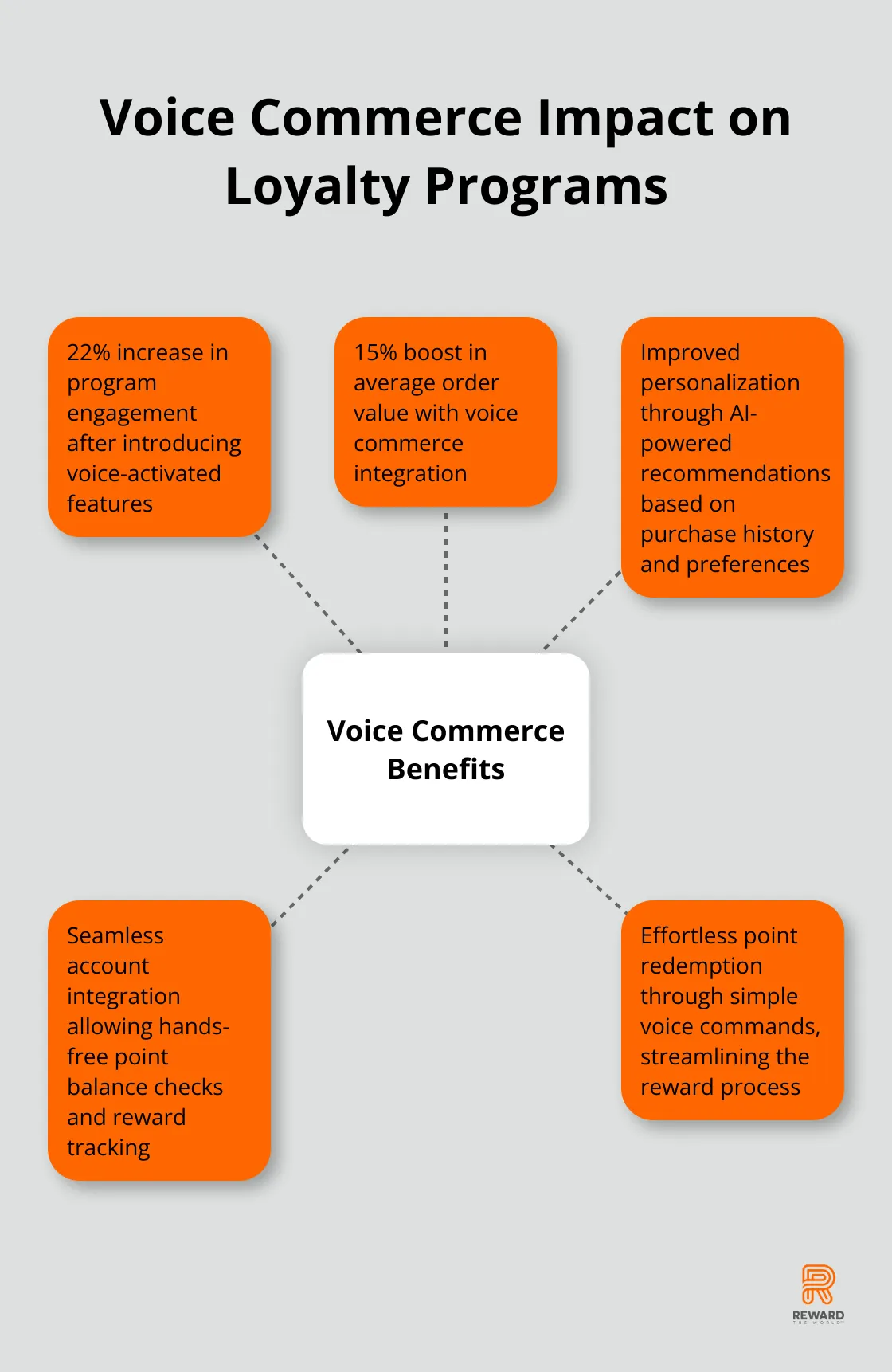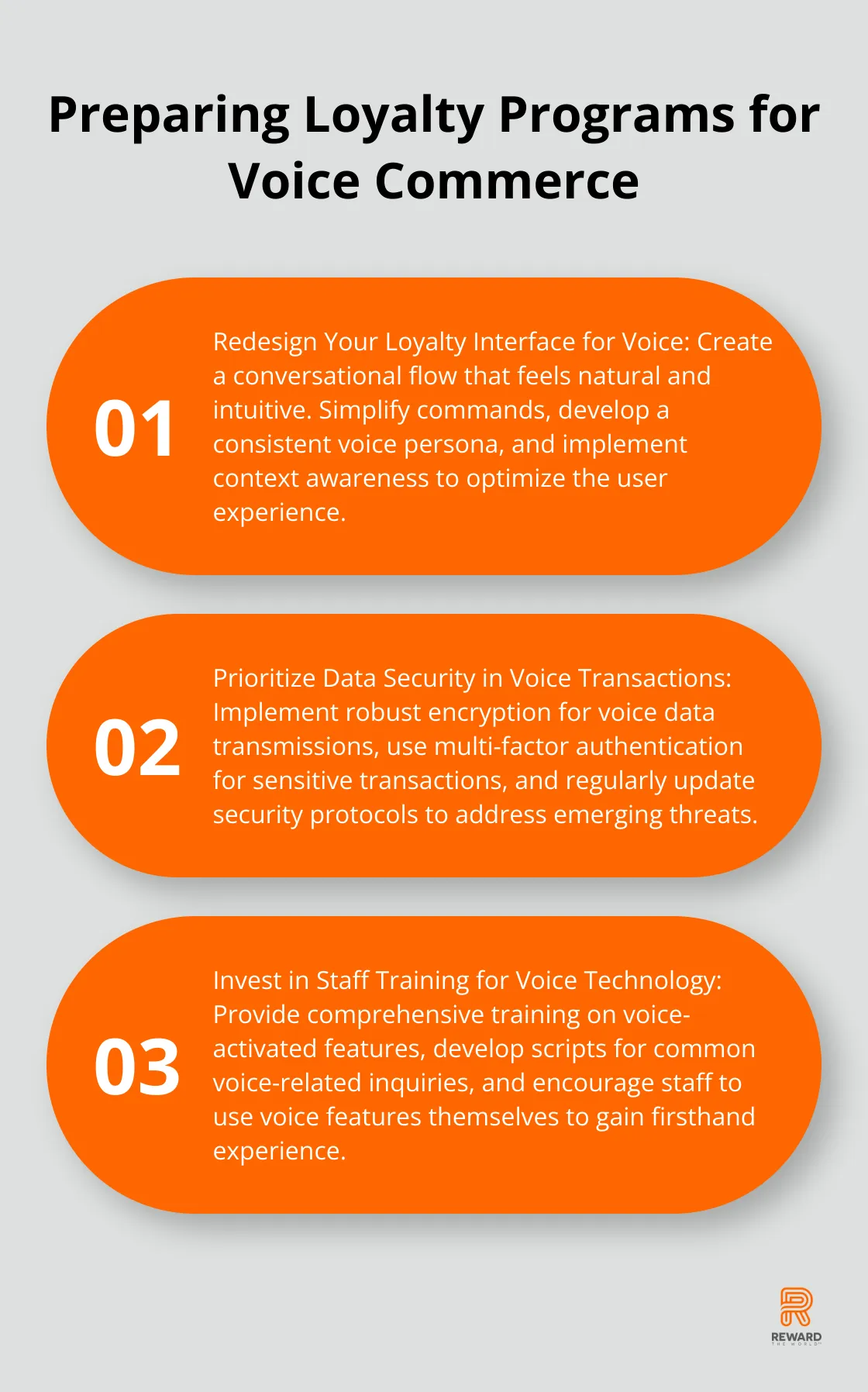
Voice commerce is revolutionizing the way consumers interact with brands and make purchases. At Reward the World, we’ve seen a surge in voice-activated shopping, transforming customer expectations and behaviors.
This shift presents both challenges and opportunities for loyalty programs. In this post, we’ll explore how businesses can adapt their loyalty strategies to thrive in the voice commerce era.
Voice Commerce Boom: What You Need to Know
The Rise of Voice-Activated Devices
Voice commerce is transforming the retail landscape. Around 8.4 billion voice assistants are expected to be in use globally by 2025, according to Demand Sage. This explosion extends beyond smart speakers to smartphones, cars, and household appliances equipped with voice recognition technology.
Consumers Embrace Voice Shopping
Voice commerce has evolved from a novelty to a preferred shopping method. By 2022, the number of voice assistant users in the U.S. reached 135.6 million, accounting for 40.20% of the population, according to Market.us. This percentage will likely increase as the technology becomes more sophisticated and user-friendly.

Shifting Shopping Behaviors
Voice commerce alters shopping habits in several ways:
- Convenience: Customers now make purchases while multitasking, leading to more frequent, spontaneous buys.
- Speed: Voice commands enable faster product searches and checkouts, reducing cart abandonment rates.
- Personalization: AI-powered voice assistants learn user preferences, offering personalized recommendations based on shopping history and trends.
Challenges for Retailers
While opportunities abound, businesses face hurdles in adapting to voice commerce:
- Search Optimization: Voice searches tend to be longer and more conversational than text searches. Retailers must optimize their content accordingly.
- Brand Recognition: Without visual cues, brand recall becomes paramount. Companies must focus on creating memorable audio branding.
- Security Concerns: As voice commerce grows, so do concerns about privacy and data security. Businesses must prioritize robust security measures to build trust.
The Future of Voice Commerce
The voice commerce boom represents a fundamental shift in consumer-brand interactions. For businesses aiming to stay competitive, integrating voice capabilities into their loyalty programs is no longer optional-it’s a necessity.
As we move forward, let’s explore how voice commerce specifically impacts loyalty programs and how businesses can adapt their strategies to thrive in this new era.
How Voice Commerce Transforms Loyalty Programs
Voice commerce reshapes loyalty programs, offering unprecedented convenience and personalization. The integration of voice capabilities into loyalty strategies has become a game-changer for businesses.
Seamless Account Integration
Voice-activated loyalty programs have become the new standard. A study predicts that 74% of respondents highlight improved speech-to-text accuracy in voice assistants by 2025. This integration allows members to check point balances, track rewards, and manage their accounts hands-free.
A customer can now simply ask, “Alexa, how many loyalty points do I have at Coffee Co.?” and receive their balance instantly. This frictionless experience encourages frequent engagement with the loyalty program.
Effortless Point Redemption
Voice-activated point redemption streamlines the reward process. Members can now redeem points for rewards with a simple voice command. Redemption rates show whether customers find rewards valuable in loyalty programs.
Picture this scenario: a customer says, “Hey Google, use my loyalty points to order my usual from Pizza Palace.” The order is placed, points are deducted, and the transaction completes – all through voice commands.
AI-Powered Personalization
Voice assistants leverage AI to offer hyper-personalized recommendations based on a member’s purchase history, preferences, and real-time context. An Accenture study found that consumers prefer to shop with brands that provide relevant offers and recommendations.
For example, a voice assistant might suggest, “Based on your recent purchases, you might enjoy our new organic green tea. Would you like to use your points to try a sample?” This level of personalization not only enhances the customer experience but also drives incremental sales.
Tangible Results for Businesses
Companies that implement voice commerce in their loyalty programs see concrete results. A case study by Voiceify revealed that a major retailer experienced a 22% increase in program engagement and a 15% boost in average order value after introducing voice-activated features.

To maintain a competitive edge, companies must prioritize voice integration in their loyalty strategies. This prioritization involves investing in natural language processing technology, ensuring data security for voice transactions, and training customer service teams to handle voice-related inquiries.
As we move forward, it’s clear that voice commerce will continue to shape the future of loyalty programs. But how can businesses prepare their existing loyalty programs for this voice-driven revolution? Let’s explore the essential steps in the next section.
How to Prepare Your Loyalty Program for Voice Commerce
Voice commerce reshapes the loyalty landscape, and businesses must adapt quickly to stay competitive. Here’s how you can prepare your program for this revolution:
Redesign Your Loyalty Interface for Voice
Reimagine your loyalty program’s user interface with voice interactions in mind. This means creating a conversational flow that feels natural and intuitive. Gartner predicts that by 2025, AI is projected to handle 95% of all customer interactions, encompassing both voice and text.
To optimize your interface:
- Simplify commands: Use clear, concise language that’s easy to speak and understand.
- Create a voice persona: Develop a consistent voice and tone that reflects your brand personality.
- Implement context awareness: Ensure your system can handle follow-up questions and maintain conversation context.
Prioritize Data Security in Voice Transactions
As voice commerce grows, so do security concerns. To build trust and ensure compliance:
- Implement robust encryption for all voice data transmissions.
- Use multi-factor authentication for sensitive transactions.
- Update your security protocols regularly to address emerging threats.
- Communicate your data protection measures clearly to members.
Invest in Staff Training for Voice Technology
Your team needs to understand voice commerce to support members effectively. Invoca reports that by 2023, AI-driven virtual customer assistants will be used by 70% of customer service organizations. To prepare your staff:
- Provide comprehensive training on voice-activated features and troubleshooting.
- Develop scripts for common voice-related inquiries.
- Update training materials regularly as voice technology evolves.
- Encourage staff to use voice features themselves to gain firsthand experience.
The success of your voice-activated loyalty program depends on your team’s ability to support and guide members through this new technology.
Integrate Voice Analytics for Deeper Insights
Use voice analytics to gain valuable insights into member behavior and preferences.
Voice analytics can help you:
- Track popular voice commands and optimize your program accordingly.
- Identify pain points in the voice user journey.
- Personalize recommendations based on voice interaction patterns.
- Measure the impact of voice features on program engagement and redemption rates.
These strategies will position your loyalty program at the forefront of the voice commerce revolution. As voice technology continues to evolve, adaptability and innovation will maintain member engagement and drive program success. Review your program’s performance regularly and prepare to make adjustments as needed to keep up with this rapidly changing landscape.

Final Thoughts
Voice commerce reshapes the loyalty landscape, offering unmatched convenience and personalization. This technology represents a fundamental shift in customer-brand interactions, not just a passing trend. The integration of voice capabilities into loyalty strategies has become essential for businesses to remain competitive and meet evolving customer expectations.
We predict that voice-driven customer engagement will grow exponentially as AI and natural language processing technologies advance. Voice interactions will become more seamless and intuitive, leading to sophisticated voice-activated personalization. Loyalty programs will offer tailored rewards and experiences based on a member’s voice patterns, preferences, and real-time context.
Businesses should act now to stay ahead in the voice commerce revolution. They can start by assessing their current loyalty program and identifying opportunities for voice integration. Reward the World can help transform loyalty programs for the voice commerce era with its global reach, instant reward delivery, and robust analytics (making it an ideal partner for businesses looking to leverage cutting-edge technology).
